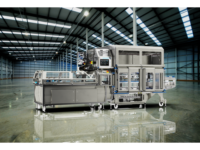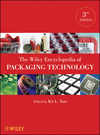Printing: Flexo Plates
Photopolymer & UV LED Technology: The Next Generation in Flexo Platemaking






As photopolymer plate formulators, manufacturers and suppliers, we often get inquiries on emerging technologies and their impact on flexographic printing plate development. Sustainability, printed electronics and 3D Printing are just a few “buzzwords” we hear a lot about, but UV LED technology may be the most “emerged” technology that we come across today. I’d like to spend a few minutes discussing how we, from the plate development and supply perspective, see this technology playing out.
UV LED Technology in Flexo Platemaking
While the most common application of UV LED in flexographic printing today is often seen as the on press or print application area, the use of UV LED for curing flexographic plates has been around for longer than one may think. The use of UV LEDs has been most successfully applied via Esko in its Inline technology that combines plate ablation systems with UV LED curing technology. In this case, the plate can be ablated and cured on the same unit. While the combination brought about an advancement in equipment consolidation, along with solid print performance that was sustained over a period of years, a separate back exposure step was still required and the additional curing step resulted in a productivity bottleneck in this technology.
An additional application surfaced within the last few years, in which UV LED light sources were used in concert with standard fluorescent bulbs to produce a flat-top dot printing plate without the need for tying up your imager. The UV LED’s main function, in this case, was to outrun oxygen during the curing step, allowing for the formation of a flat dot surface, while the fluorescent bulbs completed the bulk curing process in the printing plate. While it certainly did isolate the curing step back to a separate exposure frame and away from the imager, a modified exposure unit was required, along with the need for multiple curing steps. Thus, the productivity and expense of such a unit may not have been ideal for certain segments of the market.
The most recent addition to UV LED curing is a full LED-based, standalone exposure system. Several of these have been publicized within the past 2-3 years, with one system receiving dominant praise in the industry to date: the Esko XPS Crystal system. This system allows for simultaneous, UV LED-based curing on the back and front side of the printing plate in a manner that is consistent in its application pass to pass and plate to plate. This technology has also allowed for the introduction of a platform approach to platemaking automation, in which ablation to exposure, or further into plate processing, can be aligned together within a single production system.
UV LED Advantages
At this point, it’s important to ask the “so what?” question. Why are we even interested in UV LED curing to begin with? The answers relative to flexographic platemaking is short and simple:
Consistency: Photopolymers are not moody nor highly intelligent autonomous creatures, they are mixtures of chemicals designed with a class of behaviors and performance characteristics in mind, targeting a finished print application. They require many other technologies to be successful, such as exposure, washout, on-press components, etc. Any variation of these components can lead to variation in the application of said photopolymer materials, and this includes plate exposure technology. The more widely variable the exposure technology, the more variation one can expect from your photopolymer plate. This is where UV LED technology holds a distinct advantage, as it offers an unparalleled uniformity of light intensity across the width of the exposure device, which translates into more uniformity of the finished printing plate itself. More uniformity means more consistency, and more consistency lends itself to more repeatable and predictable finished results. This, simply put, was sorely needed within our industry. There are additional areas of benefit relative to how UV curing is applied to the printing plate. In addition to supplying consistent and predictable amounts of UV energy to the plate, applying this in a consistent manner is also important. The ability to cure each plate the same way, meaning no differences relative to temperature, energy or even the time between the front side and back side exposures, these elements lead to greater and greater consistency. And with consistency, comes standardization and predictability.
Automation: UV LEDs are extremely powerful for their size, but it’s the size itself that brings the most flexibility into the platemaking arena. UV LEDs are most aptly integrated into smaller arrays that can be applied as a light bar for platemaking in which the bar itself, or the plate, moves under the irradiation source. This allows for a streamlined design, albeit one that is still highly, highly complex in its application despite the simplicity of the appearance. This streamlined approach has enabled several integrations of UV LED designs to date. One such integration is the connection of ablation to exposure, wherein the plate is automatically transferred from one unit to the other. Additionally, several examples of exposure to processor integrations have been implemented and currently can be found within the industry today, but have been limited to solvent processing only. The ultimate consolidation is the full combination: ablation to exposure to processing. Of additional interest is how well thermal or water wash systems can integrate into this technology in the future.
Future considerations: While the automation function is certainly a future consideration when evaluating UV LED technology, the other areas of consideration are related to productivity and environmental considerations. For productivity purposes, I merely point to the expanding trends of inherently flat top formulations that have integrated into the market within the past few years, which was pioneered by MacDermid. These formulations have changed the way we view formulation possibilities and have increased the platemaking speed and efficiency as a result. Therefore, our new normal has changed - speed is here, and UV LED can help to enhance the control of these types of formulations during platemaking even further. Additionally, a long-term consideration of UV LEDs when compared to existing fluorescent systems is the environmental aspect and the elimination of mercury-based components. While not an active element in regulations today for flexographic platemaking systems, the regulations have slowly started to evolve in the areas of household lights and the elimination of incandescent lighting within some regions. There will come a time in which mercury-based light sources may well be highly regulated or even banned in the future, and we as an industry must prepare for that eventuality.
Photopolymer Interaction
So how do we, as formulators, deal with this technology? The ink formulators have borne the brunt of this emergence thus far, being forced to contend with reformulation efforts, new raw materials, functional differences, etc. On the platemaking side, there are essentially two possibilities we are forced to face: How do our current formulations interact with UV LED curing systems, and how do we modify or develop new formulations that take advantage of these light sources?
While the existing UV LED platemaking systems do target the same peak wavelength for curing, 365 nm, UV LEDs are inherently near-monochromatic (See Figure 1) when compared to fluorescent bulbs (See Figure 2).
As a result, photopolymer formulations that were developed with broad band bulbs in mind can quite possibly behave differently and unpredictably with these new systems despite their wavelength target similarities. To date, there are many formulations that have become qualified in these systems, so it’s safe to say we, as the plate developers, have had a bit of serendipity with respect to the interactions between plates and light sources. There are, however, things that we have learned about along the way that will help guide us on where to go next.
Future Developments
Future developments aren’t just because we can develop them, there are distinct benefits that are targeted specific to UV LED technology now that these light sources have become more readily available to test on and learn from. These benefits include:
Productivity: The current class of polymers in the market today have shown distinct differences in their behavior under UV LED conditions. Generically speaking, the inherently flat top dot chemistries cure much faster under UV LED conditions, similar to their behavior under bank light conditions. With the benefits gleaned from the ability to control intensity with said systems, combined with the uniformity of the intensity, there is new ability to focus on formulation speed without fear of losing control of the plate consistency. Future iterations of UV LED products can therefore be developed to best optimize the utilization and efficiency of these systems without harming final quality. When combined with the automation aspect, this has intriguing possibilities for the platemaking facilities of the future.
Optimized cure/performance: In addition to the monochromatic wavelength structure of UV LED systems, the other main difference in UV LED systems is the overall lamp intensity. It is much higher than typical bank light systems. As a result, the curing mechanism itself can radically change. This has been observed to occur with two main defects on the finished printing plate: inconsistent or unpredictable dot gain, and dot cupping. While certainly addressable via optimization of process/curing conditions, the goal of new plate developments is to widen the platemaking window, thereby allowing for a broader range of optimum conditions that aren’t impacted by slight changes in graphics, relief targets, print applications, etc. — the usual plethora of conditions that are dealt with by all of us in the industry.
It is a key plate strategy to be prepared for this technological emergence and adoption, rather than waiting for it happen. By working very closely with the suppliers of the UV LED technologies, any platform strategy is focused on two areas of strength:
High qualify formulations that exist today, qualified and proven to work in UV LED systems.
Newer technology platforms that are developed to be tuned to UV LED light sources, providing even greater productivity and wider performance latitude than plate technologies that currently exist.
Improved quality, productivity and efficiency are areas that will help drive more market share toward flexo and away from our competing technologies, while continuing to maximize profit along the way.
MacDermid Graphics Solutions
Looking for a reprint of this article?
From high-res PDFs to custom plaques, order your copy today!












